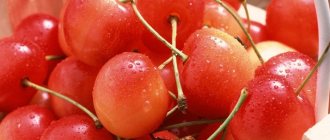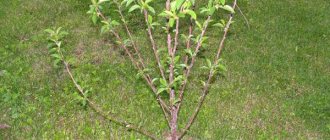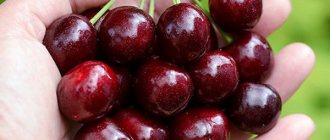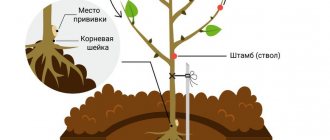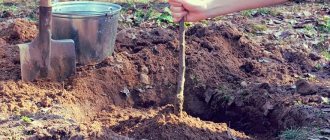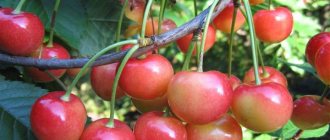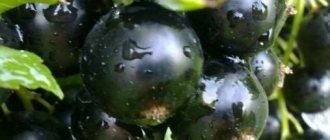Leningradskaya black cherry was bred by Russian breeders specifically for the gardens of the Non-Black Earth Region, the north-west and north of the central region. The name of the variety was given by the name of the place - the cherry was bred in St. Petersburg by scientists from the Pavlovsk Experimental Station. The second part of the name comes from the appearance and color of cherry berries.
The Leningradskaya Black cherry variety appeared on the list of those recommended for cultivation relatively recently, and although it has not yet been included in the State Register, it is popular among gardeners in the northern regions.
The Leningradskaya Black cherry variety has positive reviews from both those who grow it and those who consume the fruit.
Features of the Leningradskaya black cherry variety
The variety was specially bred in order to be able to grow cherries not only in hot climates (like previously known varieties), but also in northern latitudes. He sectioned the culture at the St. Petersburg Pavlovsk Scientific Station of the All-Russian Institute of Plant Growing F.K. Teterev. in 1994.
Leningradskaya black cherry attracts the attention of gardeners due to its ease of care, high yield and resistance to frost. In addition, the fruits of the crop are sweet, moderately tart and do not fall from the tree after ripening. The berries also tolerate long-term transportation well, and the mature tree is compact and has a lush crown.
Ripe berries are used fresh in cooking and for the preparation of alcoholic products (wines, liqueurs). You can also make jam, jam and compotes from cherries, but the preparation will have a tart aftertaste.
Planting Leningradskaya Black cherry variety on a plot: step-by-step instructions with photos
It is recommended to buy cherry seedlings from specialized nurseries so that they match the variety. Both spring and autumn are suitable for planting cherries of the Leningradskaya black variety. Spring planting is more suitable for seedlings with an open root system, and autumn planting is more suitable for seedlings with closed roots.
Cherries love a sunny area, protected from the wind by a wall or fence. Monitor the presence of groundwater nearby. The level cannot be too high, otherwise the root system will be damaged by rot.
Leningrad black cherries like sandstone and loam. The cherry tree is planted in a planting hole previously dug to the size of the rhizome. The soil in the planting pit is fertilized with superphosphate, humus, and potassium chloride.
Under no circumstances should you use fresh manure, as it can burn the roots and destroy the seedlings.
If there is no other cherry tree on the site, you should purchase it.
The second cherry tree should be planted no further than three meters away. Plants need pollinators, since the yield and quality of cherry berries depends on this.
Advantages and disadvantages
Leningradskaya black cherries, the description of the variety and photos of which allow you to evaluate the advantages and disadvantages of the crop, can be grown both for wholesale sale and for individual use.
Gardeners and gardeners have identified the following pros and cons of the variety:
| Positive and negative characteristics of cherries | |
| Advantages | · the tree tolerates frosts well in winter and temperature changes during the flowering period; · berries have a sweet taste and a slight tart aftertaste; · the tree is stable in bearing fruit; · mature cherries are not tall, making it easier to pick berries; · the berries begin to ripen towards the end of July and continue to ripen until September; · berries do not fall off even after ripening; · fruits can be used fresh, for preparing and preparing alcoholic beverages; · the seedling begins to bear fruit in the third year after planting; · the tree and fruits are resistant to most pests and diseases; · berries do not spoil when transported over long distances; · tree productivity is high. |
| Flaws | · the bone is difficult to separate from the pulp; · in rainy summers, the berries have a watery texture and the skin cracks; · to obtain a harvest, it is necessary to plant a pollinator nearby, since the variety is self-sterile; · the berries are medium in size; · berries ripen unevenly (the harvest is harvested within 2 months); · If there is insufficient moisture, the quantity and quality of the crop decreases. |
Leningradskaya black cherry produces a lot of tasty berries.
Another advantage of the crop is its spreading crown and good foliage, which protects the berries from the scorching rays of the sun in the heat.
Frost resistance
One of the qualities for which Leningradskaya black cherries are valued is winter hardiness. But it can still freeze, especially at a young age. Reviews recommend mulching the tree trunk with horse manure. Of course, if it is possible to get it.
It is recommended to wrap a young tree trunk with a special covering material or use old nylon stockings for this purpose. The main condition: the shelter needs to allow air and moisture to pass through.
In early spring, the trunk is treated with a solution of slaked lime. It protects the bark from sunburn and destroys pathogens and small pests.
To protect from the sun, you can use the same stockings. It’s better to wrap them around as much of the trunk and branches as possible.
Leningrad black cherry grows well in the south of the Non-Black Earth Region and the entire territory of the Central Black Earth region.
Characteristics of culture
Leningradskaya black cherry differs from other varieties in its frost resistance, unusual berry color and high annual yield in all weather conditions.
Ripening period
The first berries of the Leningrad black cherry can begin to be collected in July (in hot climates in mid-June), and the harvest ends in September. The tree begins to bloom (inflorescences usually consist of 5 flowers) approximately in mid-to-late May, so the risk that the buds or ovaries will freeze during spring frosts is minimal. Due to the extended ripening period, fresh cherries can be consumed within 2 months.
Drought resistance, frost resistance
Leningradskaya black cherry, the description of the variety and photo of which are presented in the article, does not die and does not stop bearing fruit during drought and frost, but subject to the following rules. When it is hot, the tree needs to be watered more often and more abundantly, and in winter frosts, to prevent the roots from freezing, it is necessary to sprinkle them with snow or apply additional insulation.
In addition, abundant watering is needed during the formation of the ovaries, but it is important not to overwater the root system, since strong moisture spoils the texture and taste of the berries.
Appearance of plant and fruit
Mature cherries have a small height of up to 4 m (when compared with classic southern varieties, whose height is up to 10 m), spreading and moderate foliage, the bark has a brownish-brown color and a fairly soft texture. The foliage on the tree is large, with jagged edges, dark green in color and oval in shape. During the flowering period, the branches of the tree are covered with white buds, collected in small inflorescences, giving the cherry a fabulous appearance.
Ripe fruits of the Leningrad black cherry have the following characteristics:
| Fruit parameters | Description of parameters |
| Size | Medium size |
| Weight | Approximately 4 g |
| Form | Round-heart-shaped |
| Skin | The skin is thin, dense with a pronounced dark red (almost black) color. |
| Pulp | Dense, juicy and moderately fibrous. The color of the pulp is burgundy. |
| Bone | The pit is difficult to detach from the pulp |
| peduncle | The stalk is easily separated from the branch |
| Taste rating | On a 5-point scale 4.2 |
Ripe berries have a sweet-tart taste with a slight sourness and spicy aroma. The tart taste of the fruit is a plus when preparing wines and liqueurs from the berries, but when preparing preparations (jam, compotes) this property is a minus.
Productivity
Black Leningrad cherry needs to be planted with pollinators at a distance of about 3 m, otherwise the number of ovaries from flowering will be no more than 5%. The gardener can choose a pollinator independently. Recommended varieties for pollination (Tyutchevka, Revna, Michurinka). If these conditions are met, cherries will produce a harvest every year.
If you follow the rules for caring for cherries, you can remove up to 20 kg of young cherries from one tree and up to 40 kg of berries from an “adult” tree. It will not be possible to pick all the berries at once, as they ripen gradually. If the fruits are not collected immediately after ripening, they do not fall off, and their taste does not deteriorate.
Interesting to know. Fallen cherries do not spoil and can be transported and stored no worse than fruits picked from a tree.
Late cherry “Leningradskaya black”, photo of planting in a hole
Cherries are watered once a week. A bucket of water is enough to water one young seedling. If the summer is dry, it is recommended to increase the frequency of watering. If the cherries are already bearing fruit, stop watering in July to avoid cracking of the berries.
Features of planting and growing
Leningrad black cherries can be grown in any climate; this property makes the crop attractive to gardeners. The variety produces a large harvest every year. The following article presents the rules for planting and growing seedlings, features of harvesting and storing crops, accompanied by a detailed description and photo.
Soil and planting algorithm
The seedling should be planted in an area well lit by the sun and protected from strong winds. For example, you can plant cherries near a house or fence. It is also desirable that the terrain be level and the groundwater be approximately 2.5 m away from the ground. The soil for planting seedlings should be sufficiently loose, saturated with fertilizers and moisture.
If the soil is dense, then it is recommended to add sand to it, since otherwise the cherry roots will not receive the required amount of oxygen. Depending on the climate, seedlings are planted seasonally. If the weather in the region is cold, then planting should be done in early spring, while the buds on the tree have not yet blossomed. And if planting is carried out in a hot climate, then you need to wait until the leaves fall from the seedling in the fall, and then replant it.
The process of planting cherries should be carried out according to the following algorithm:
- The purchased seedling must be checked for diseases, the presence of pest larvae, and dried branches must be removed.
- If the root system of the tree is overdried, then the seedling must be placed in a bucket with a growth enhancer for approximately 6-10 hours.
- Prepare the soil for planting. To do this, the selected area needs to be dug up, removing insect larvae and weed roots. If the soil is dense, then add sand to it.
- Fertilize, thoroughly water and disinfect the soil, and let it rest before planting the seedling for about 10 days.
- Dig a hole in the ground with a diameter of approximately 1 m and a depth of about 0.7 m. It is necessary that the hole be located approximately 4 m from other trees or bushes.
- Place a drainage up to 6 cm high, soaked with fertilizers, on the bottom of the hole. A mixture of 1 kg of ash, 5 kg of compost and approximately 300 g of fertilizer should be used as drainage.
- Water the drainage with about 15 liters of water and let the hole rest for about 12 days.
- After 12 days, drive a wedge approximately 1.5 m high into the hole, place the seedling, and carefully straighten the roots during planting.
- Carefully tie the seedling to the wedge. It will prevent young cherries from breaking during periods of strong winds.
- Fill the void in the hole (on top of the roots) with a mixture of ash, compost and soil.
- Water the ground near the seedling and around it with about 17-20 liters of warm water. Thanks to water, the earth will not only be moistened, but will also subside. After significant subsidence, place another layer of soil on top of the roots of the seedling.
- For ease of watering, and in order not to wash away the soil near the roots, make a kind of ditch around the seedling.
It is advisable to buy seedlings in trusted stores. Their age should be 1-2 years (height approximately 80-120 cm), no more. Since older seedlings take root less well. A high-quality seedling should not have cracks in the root system, and there should be about 3-4 branches with leaves on the trunk.
Trimming
During the growth process, branches that have dried out or broken in the winter should be removed. They also remove branches that have grown towards the center (toward the trunk), since ovaries rarely appear on them, and they greatly thicken the crown, interfering with harvesting. The pruning process is required before the buds begin to open and after picking the berries. Since if you remove branches during the fruiting period, manipulations can affect the amount of harvest.
Important. It is undesirable for cherry branches to be more than 50 cm long, so they need to be pruned at the indicated periods. You can cut off the top branches of cherries before the tree reaches 6 years of age. After this, pruning is not performed, since the tree grows while maintaining the given crown shape.
Care
In spring and summer, you need to make sure that the tree receives enough moisture. Since during drought, the formed ovaries may fall off, and the berries will not have a juicy texture. To do this, during the flowering period, then during the formation of ovaries, and also after harvesting, it is necessary to water the seedling with warm water in an amount of approximately 20 liters. It is important not to overwater the cherries, as otherwise the appearance and taste of the berries will deteriorate.
Protect the tree bark from the sun's rays with whitewash or soft material, otherwise it will begin to crack and the cherry will die. During the summer season, it is necessary to remove growing weeds, since they not only take away some of the nutrients from the seedling, but are also the main cause of infection of cherries with diseases and pests.
In mature cherries, a large number of berries form on the branches, therefore, to prevent them from bending too much (and also to prevent them from breaking), it is recommended to install supports under large branches.
To maintain high yields, Leningrad black cherries need to be fertilized annually according to the following algorithm:
- in the period from May 1 to May 10, it is required to apply a mixture of fertilizers from urea, superphosphate and potassium sulfate (take 20 g of each substance). This amount of fertilizer is calculated for 1 m2.
- At the end of picking berries, fertilize the soil with fertilizers containing potassium and phosphorus.
- Before wintering, you need to carefully dig up the soil near the cherry tree (be careful not to injure the roots), add superphosphate and potassium salt. Combine the process with autumn watering of cherries.
Cherries will bear worse fruit and be susceptible to diseases and pests if they are planted next to plums, apricots or apple trees. And hawthorn, rowan and grapes are “desired” neighbors. You can also improve the pollination of the variety by planting honey plants next to the tree.
Cherry care
When caring for cherries, you need to take into account the characteristics of the Leningradskaya Black variety: spreading crown and extended ripening of the crop.
Trimming
Immediately after planting, the first pruning is carried out, shortening the trunk at a height of 60–65 cm. This stimulates the formation of lateral skeletal shoots, which will facilitate harvesting in the future. Further pruning is carried out in order to create a sparsely layered crown, which will provide better illumination of the branches and limit the height of a medium-sized tree. After the final formation of the crown, pruning removes weak, diseased, injured, growing inside the crown, rubbing and crossing branches.
The formation of a sparsely-tiered crown is completed in the 4th–5th year by removing the upper part of the central conductor above the last skeletal branch at a height of 3.5–4 m from the ground
Watering and mulching
Cherries need to be watered regularly, but in moderation. Excessive watering can lead to stagnation of water and rotting of the roots. In addition, water displaces air from the soil, and roots need oxygen no less than water for normal functioning. The need for watering is judged by the condition of the soil under the mulch.
Some gardeners believe that cherries should not be watered after the harvest has ripened, as this will lead to cracking of the berries. According to others, cracking of fruits occurs due to irregular watering.
In the case of the Leningradskaya black cherry, you cannot stop watering, since its fruiting is extended. It is better to carefully monitor the condition of the soil and regularly provide plantings with water, depending on weather conditions and the needs of the tree. Basic recommendations for watering: add 5-7 buckets of water during flowering and ovary formation, do not forget to water abundantly after harvesting and 3-4 weeks before the expected frost to prepare the trees for winter.
Cracking of berries can occur due to irregular or excessive watering
In the spring, when the earth warms up, the tree trunk circle is covered with any organic material: pine needles, straw, peat, humus, sawdust, crushed tree bark, and withered mown grass. Mulch protects the roots from overheating, prevents excessive evaporation of water, suppresses the growth of weeds in the tree trunk and gently replenishes moisture and organic compounds when the greens are overheated. What remains of the mulching material in late autumn is mixed with the soil with a hoe.
Feeding
If a sufficient amount of organic matter is added to the planting hole, then for the next 3–4 years you can forget about further fertilizing. And if you make a rule before winter to mulch the tree trunk circle with rotted compost, horse manure or humus, and practice adding ash to the mulch in the summer, you can be confident in the harvest. When applying mineral fertilizers, the following principles are adhered to: nitrogen fertilizers are applied in the spring, phosphorus and potassium fertilizers are applied throughout the season. Phosphorus salts are usually added twice as much as nitrogen or potassium salts.
Agronomists with extensive experience do not recommend getting carried away with applying mineral fertilizers without checking the actual mineral composition of the soil on your site.
Disease prevention and winter preparation
Trees that have developed good immunity as a result of proper care usually do not get sick and are resistant to adverse environmental factors. The first winters are especially important for young seedlings, when, in addition to cold weather, hares that eat young shoots and trunks pose a danger. For protection, it is recommended to tie the seedlings with thick paper bags, corrugated cardboard or spruce branches. In the future, you need to whiten the trunk and main skeletal shoots to protect them from frost damage.
The Leningradskaya Black variety is considered resistant to disease, but experienced gardeners recommend treating cherry plantings with Bordeaux mixture (100 g per 10 l of water), copper sulfate (100 g per 10 l of water) or urea (700 g per 10 l of water) in early spring for prevention. .
You should not leave fallen diseased leaves under a tree, much less put them in compost.
Harvest preservation
The experience of many years of gardening convinces that birds quickly get used to bright disks, scarecrows and dummies of birds of prey hung on the branches. The fruits of the Leningradskaya black cherry hang for a long time, so to preserve the harvest, you should take care of covering the crown with a net.
Video: how to save crops using a net
Diseases and pests
Leningradskaya black cherry (a description of the variety and photos of possible pests help protect the tree and berries from spoilage) is resistant to diseases and insects.
But in order to achieve a high yield, experts recommend treating the crop for preventive purposes against the following pests and diseases:
| List of diseases and insects | Symptoms of damage and danger | Fighting methods |
| Clusterosporiasis | When infected, dark spots first appear on the leaves, and then holes form in place of the spots. Gradually, the leaves begin to fall off the cherry tree and the berries begin to dry out. | To prevent the disease in spring, it is necessary to treat the tree with Bordeaux mixture. If the disease is detected at the development stage, then all infected leaves should be removed and the cherries should be treated with copper sulfate. |
| Moniliosis | Infection manifests itself by the appearance of spots on the fruits, and the berries also acquire a pronounced alcoholic taste, since, due to the activity of the fungus, they begin to ferment during the growth process. Gradually the berries begin to fall off. | To prevent infection, cherries should not be allowed to grow in high humidity, branches should be pruned in a timely manner, and the bark should be treated with disinfectant solutions in the spring. If infected, the tree and berries can be treated with Bordeaux mixture or antifungal agents. |
| Aphid | The pest, having settled on a tree, begins to actively destroy the foliage; as a result, not only does the quantity and quality of the harvest decrease, but in the absence of control methods, the cherry may die. In addition, aphid excrement causes the development of fungal diseases in cherries, and the insects themselves attract ants. | Prevention of infection consists of regularly removing weeds, breeding ladybugs in the area (they feed on aphids) and regularly checking the tree for traces of infection, as well as treating the tree and berries with a soap solution. When infested with aphids, the following drugs are recommended for use: Karbofos or Arrivo. You can also use an iodine solution or a decoction of garlic or onion peels. |
| cherry fly | The insect lays larvae in the pulp of the fruit. in which they develop. It is not always possible to notice a lesion externally. The larvae can usually be found by breaking open the berry and revealing the worm. Also, the affected fruit acquires a bitter taste. | To protect, cherries must be disinfected before flowering, after the formation of ovaries and at the beginning of berry ripening, with protective agents. You can also hang fly tape on the tree or treat the trunk and berries with decoctions of garlic, tobacco or wormwood. To kill flies, it is recommended to use the drugs Aktara and Actellik. |
| Cherry pipe maker | Insect larvae penetrate the berries and eat the seeds. After this, they hibernate from the fruit into the soil. As a result of the pest's activity and due to its fertility, the entire harvest can be lost. | For prevention in spring, the soil must be carefully dug up, destroying the larvae. If a parasite is detected, the soil, trees and berries should be treated with Aktara. It is also necessary to shake the cherry so that mature individuals and damaged fruits fall to the ground. |
| Birds | Birds feed not only on ripe fruits, but also on berries that are at the ripening stage. A large stand can destroy a crop in a day. | For protection, you should hang shiny or rustling objects on the cherry tree. You can also cover the cherries (or rather the fruits) with a special mesh or install ultrasonic devices. |
Important. When cherries become infected, it is recommended to use folk remedies so as not to reduce the benefits of the berries. Use chemicals only in extreme cases. It is also necessary to check the cherries more often for traces of damage, process the wood in a timely manner, destroy weeds and insect larvae found, since prevention of infection is the best and safest method of control.
Description of varieties
Black cherry fruits are dark in color and have a sweet and sour taste. It is best to pick them before they are fully ripe, as overripe berries may burst.
Among the black varieties, the most popular are:
- "Black Prince";
- "Leningradskaya black";
- "French black";
- "Black Sweetness";
- "Rossoshanskaya";
- "Mlievskaya";
- "Daybera";
- "Melitopol";
- "Ilchishina."
"Leningradskaya black"
It is characterized by frost resistance and endurance. It takes root well in areas that do not have hot summers and warm winters. Even being in a place that does not have an abundance of sunlight and heat, cherries consistently produce a good harvest.
The tree grows to a height of 4-5 m and is capable of bearing the first fruits already in the third year after planting. The plant grows so that its branches form a dense crown that does not allow air and sunlight to pass through. You can recognize the Leningradskaya Chernaya variety by its large elliptical leaves and sharp tips.
The crop blooms in May, and the first harvest can be obtained at the end of June. In the coldest areas, the first fruits can be harvested a little later - at the end of July. At the same time, the berries of this variety ripen unevenly, which allows you to enjoy their pleasant taste for a long time.
"Black Sweetness"
It is characterized by partial self-fertility and cross-pollination, which allows for better ovaries. This variety is frost-resistant and easy to care for. He is not afraid of coccomycosis, a disease that negatively affects the yield and viability of the plant.
“Black Sweetness” blooms at the end of May, and bears its first fruits in July. Its berries are medium in size and have a dark burgundy color. Their flesh is dark red in color and has a sweet taste.
"Black Prince"
It grows up to 3-3.5 m and has a medium spreading crown. It is not afraid of frost and is resistant not only to diseases, but also to pests. An adult plant can produce more than 15 kg of berries, and with proper care this number can increase significantly. “Black Prince” bears its first fruits in early June and has large berries of a dark burgundy color.
This variety is self-sterile and therefore needs pollinators. In order to get a stable harvest, other varieties should be located near the cherries, for example, “Iput” or “Fatezh”.
Cherries grow in temperate climates and can take root even in the middle zone of the country.
In the southern regions, “Black Prince” seedlings can be planted in the fall, but in cold places they can only be planted in the spring.
"Rossoshanskaya"
SeedrPlayer(, onVideoStart: function () , onError: function (e) ); } });
A medium-sized, self-fertile plant with a pyramidal-stack-shaped crown and an average number of leaves. A young plant can produce more than 5 kg of yield, while mature cherries have a yield of more than 16 kg. The variety is quite frost-resistant, and therefore can be grown in central Russia. But unexpected frosts during budding and flowering can damage the tree.
The berries are almost black with a red tint. They are distinguished by their large size and round or oval shape.
"French black"
A vigorous variety with a wide spreading crown. The leaves have an oval shape with pointed tips, a smooth blade and a dark green color. Sweet cherries are not afraid of drought and can get the necessary moisture even from deep layers of soil. Reviews from gardeners indicate that it is not subject to frost and shows good frost resistance.
Unlike other varieties of black cherries, “French Black” begins to bear fruit only in the 6th year. It is capable of consistently producing crops for more than 20 years, but the best fruiting can be achieved only 12-15 years after planting.
Among the disadvantages of the variety are its vigorous growth and instability to early frosts.
"Mlievskaya"
A medium-sized, self-sterile variety that needs a good pollinator. Cherry is distinguished by a round thickened crown and oval jagged green leaves. It bears fruit at the end of June. The berries are large in size and dark burgundy in color.
According to experienced gardeners, “Mlievskaya” cherries are good because they are not afraid of fungal diseases and bear sweet fruits.
The above varieties of black cherries have good characteristics, and therefore are most often found in garden plots. However, many gardeners prefer less popular varieties. For example, “Daybere”, which is a medium-sized plant with a dense, rounded crown. Its leaves are oval in shape with a rounded base. The tree begins to bear fruit 5-6 years after planting and blooms mainly at the end of June. Since it is self-sterile, pollinating varieties must be placed nearby to pollinate it.
The Daibera variety does not have good frost resistance and is not very resistant to pests and diseases. But it has high productivity and tasty fruits, so it is quite popular for growing in the southern regions of the country.
But “Melitopol” and “Ilchishina” cherries are grown because they not only have tasty large fruits, but also tolerate transportation well.
Harvesting
Berries are picked from cherries in 2-3 batches, as the fruits ripen gradually. It is necessary to collect carefully so as not to damage the pulp. First of all, you should collect berries located on the lower branches of the tree, and then on the top (it is recommended to use a ladder), then the likelihood of fruit shedding is reduced.
To harvest, it is advisable to place a cloth on the bottom of the prepared container, then the berries are less damaged. In addition, you need to take into account that it is better to collect in the morning, when the pulp of the berries is denser.
Harvest rationing
Every gardener who has grown young trees knows how eager he is to see the fruits of a new variety. But there is no need to rush into this. The main task is to get a strong, healthy tree. And then enjoy its sweet, cool fruits to your heart’s content.
If the tree you planted blooms in the first year, it is better to remove all the buds. Can't you raise your hand? Well, if it is strong and develops well, you can leave about a fifth of the resulting flowers. There is no guarantee that at least one berry will ripen, but there is still a chance.
Subsequently, in the spring, if possible, half of the formed ovaries (not flowers!) are cut off. This will allow you to get large and tasty fruits. And the load on the tree will be less. Typically, cherries in the middle zone bear fruit within a year. If you normalize the number of fruits, then next year it can produce a decent harvest.
Reproduction methods
To propagate cherries, it is not necessary to buy seedlings; if the tree is already growing on the site or with neighbors, then you can grow a seedling yourself using the following methods:
- cuttings. The cut cuttings with leaves must first be germinated under a film in the soil required by the given crop (described in the growing conditions). After approximately 1.5 months, the cuttings should give roots. After this, the film can be removed. It is advisable to replant the finished seedling in the autumn;
- shoots The shoots that form on the roots during the summer season can grow up to 1 meter in height. In autumn, the root and shoot need to be dug up and transplanted to a designated place. To prevent young cherries from freezing, they must be well insulated for the winter.
Growing a seedling from a seed (from fruit) is not advisable, since the process is labor-intensive and there is no guarantee that the grown tree will produce a high yield.
Landing place
Cherry prefers sandy or loamy soils with neutral acidity pH 6.5-7.0. A prerequisite for obtaining a decent harvest is the correct planting location. Leningradskaya black cherry loves to grow in a well-lit place. In the shade it stretches upward, there will be few fruits, and even those are unsweetened. It will be difficult to get them, since the trunk will be thin and flexible, the branches are located at a great distance from each other. Considering the tendency of young cherries to freeze, it is better to plant them before construction on the south side.
Groundwater should approach the surface level to a depth of one and a half meters or more. If it is smaller, then the cherries need to be planted on a hill or drained. Stagnation of water in the root system can lead to the death of the Leningrad black cherry tree.
Where to buy, how much it costs
It is recommended to buy seedlings in special stores, since when purchasing cherries from hand, they may be infected with disease or pests, and there is also a high probability of purchasing a tree of a different variety. When contacting a special store, you can ask the seller for documents for the seedling and receive a guarantee. When purchasing an ordinary seedling 1-2 years old, the price will be approximately 500-600 rubles.
But cherries grown in special containers take root better. For such a product the cost rises to 1100-1300 rubles. Black Leningrad cherry is popular in northern latitudes due to its high annual yield. Another advantage of the crop is the ability to transport the crop over a long distance. The downside of the variety is the need to plant pollinators. Advice. Before purchasing a seedling, you need to thoroughly study the description of the cherry tree, as well as photos of the fruit.
History of the variety's creation
The Leningradskaya black cherry variety was bred by Russian breeders from the Pavlovsk experimental station, located near St. Petersburg. When developing a new variety, experts tried to ensure that the cherry had increased frost resistance. And they succeeded - the Leningradskaya black cherry variety became one of the first with good winter hardiness.
Photo of Leningradskaya cherry
The variety is recommended for cultivation in the Central Russian regions, in the south of the North-Western part.
Brief overview of Leningrad black cherries - video
Variety Napoleon black
Cherry variety Napoleon
Black Napoleon is one of the oldest cherry varieties with dark red berries, bred by Western European breeders. In our country, it is successfully grown in the Krasnodar region and the North Caucasus.
The tree is very tall, often reaching 7 meters. Large berries weighing 6-7 g ripen at the end of June. The average yield is about 28 kg, and under particularly comfortable conditions you can harvest up to 70 kg from one plant. Ripe fruits have a pronounced, slightly tart taste.
One of the features of the Napoleon variety is its high density of berries. Thanks to this, they are perfectly preserved during transportation and are widely used for preparing compotes and other preparations.
Cherry propagation
Cherries can be propagated by grafting, seeds and cuttings.
The most effective method of propagating cherries is the grafting method. This method requires cuttings and rootstock. Cuttings of several varieties are cut in the fall and stored in a cool place. The rootstock is shoots and seedlings. 1-2 weeks before the start of active sap flow, copulation is carried out - oblique cuts of up to 5 cm are made on the rootstock and scion, an additional cut of up to 1 cm is made on both sections. The scion and rootstock are connected to each other in a lock, creating immobility, and wrapped with a special tape or tape.

